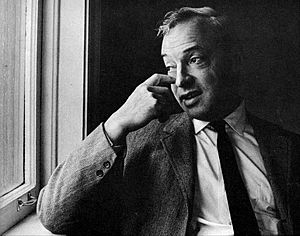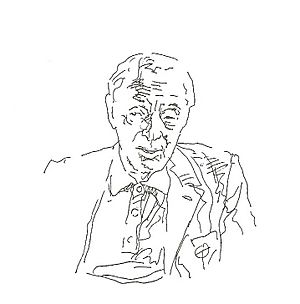Saul Bellow facts for kids
Quick facts for kids
Saul Bellow
|
|
|---|---|

Photo portrait of Bellow from the dust jacket of Herzog (1964)
|
|
| Born | Solomon Bellows July 10, 1915 Lachine, Quebec, Canada |
| Died | April 5, 2005 (aged 89) Brookline, Massachusetts, U.S. |
| Occupation | Writer |
| Nationality | American |
| Alma mater | Northwestern University |
| Notable awards | Nobel Prize in Literature 1976 Pulitzer Prize for Fiction 1976 National Medal of Arts 1988 National Book Award 1954, 1965, 1971 |
| Spouse |
|
| Children | 4, including Adam Bellow |
| Signature | |
 |
|
Saul Bellow (born Solomon Bellows; July 10, 1915 – April 5, 2005) was an important American writer. He won many top awards for his books. These include the Pulitzer Prize, the Nobel Prize for Literature, and the National Medal of Arts.
He is the only writer to win the National Book Award for Fiction three times. In 1990, he also received a special lifetime award for his great contributions to American writing.
Some of his most famous books are The Adventures of Augie March, Henderson the Rain King, Herzog, and Humboldt's Gift. Bellow once said that the character Eugene Henderson, from Henderson the Rain King, was the most like himself.
Bellow's stories often show characters trying to find meaning in a confusing world. They try to rise above difficult situations and learn a lot. His characters often deal with the big challenges of the 20th century.
Contents
Saul Bellow's Life Story
Early Years and Family
Saul Bellow was born Solomon Bellows in Lachine, Quebec, Canada. This was in 1915, two years after his parents moved there from Russia. His family was Lithuanian-Jewish.
When he was eight, Bellow got sick with a breathing problem. This time helped him learn to rely on himself. It also gave him a chance to read a lot. He decided to become a writer after reading Uncle Tom's Cabin.
When Bellow was nine, his family moved to Chicago. This city became the setting for many of his novels. His father worked in different jobs, like selling onions and delivering coal. Bellow's mother died when he was 17. She wanted him to be a rabbi or a musician. But Bellow chose to write instead. He loved reading the Torah from a young age. He also enjoyed books by Shakespeare and great Russian novelists.
School and First Steps as a Writer
Bellow went to the University of Chicago and then Northwestern University. He studied anthropology and sociology. Some people think his study of anthropology influenced his writing style.
In the 1930s, Bellow worked for the Federal Writer's Project in Chicago. This project helped writers during a tough economic time. Many future famous writers were part of it.
During World War II, Bellow joined the merchant marine. While serving, he wrote his first novel, Dangling Man (1944). It was about a young man waiting to be drafted for the war.
In 1948, Bellow received a special award called a Guggenheim Fellowship. This allowed him to move to Paris. There, he started writing The Adventures of Augie March (1953). This book helped him become known as a major author.
Return to Chicago and Famous Books
Bellow lived in New York City for some years. But he moved back to Chicago in 1962. He became a professor at the University of Chicago. He taught there for over 30 years. He liked Chicago because he felt it was more like America than New York. He could also stay in touch with old friends.
In 1964, his novel Herzog became a bestseller. Bellow was surprised by how popular it was. The book is about a college professor who writes letters but never sends them.
He explored similar ideas in his 1975 novel Humboldt's Gift. For this book, Bellow used his friend, the poet Delmore Schwartz, as inspiration for a character.
Nobel Prize and Later Life
Because of the success of Humboldt's Gift, Bellow won the Nobel Prize in Literature in 1976. In his speech, he asked writers to guide civilization. He wanted them to help people think clearly.
Bellow traveled a lot during his life, especially to Europe. He met many different kinds of people. He was friends with other writers like Ralph Ellison.
While his first books sold modestly, Herzog changed that. Bellow continued teaching even when he was old. He enjoyed talking with students and sharing ideas. He taught at several universities, including Yale University and Boston University.
He passed away on April 5, 2005, at the age of 89. He is buried in Vermont.
By the time he died, Bellow was seen as one of the greatest living novelists. His friend and fellow writer Philip Roth said that Bellow was a "backbone of 20th-century American literature."
Personal Life
Saul Bellow was married five times. His sons, Greg and Adam, both became writers. Greg wrote a memoir about his father. Adam wrote a nonfiction book. In 2000, when Bellow was 84, he had his fourth child, a daughter.
Themes and Writing Style
Bellow's books often explore how confusing modern society can be. He wrote about people's ability to overcome challenges and achieve great things. He felt that modern life had many problems.
His main characters often have heroic qualities. They stand out against the negative parts of society. Many of these characters are Jewish and feel a bit different from others.
Jewish life and identity are important in Bellow's work. He also showed a great love for America. He was fascinated by the unique and lively American experience.
Bellow's writing often includes references to famous authors. But he also added jokes and humor. Many of his characters were similar to himself.
How People Saw His Work
Many people thought Saul Bellow was an amazing writer. Martin Amis, another famous author, called him "The greatest American author ever."
Some people, however, felt his writing was a bit old-fashioned. But many praised his shorter works. For example, his novella Seize the Day was called a "small gray masterpiece."
Political Ideas
As he got older, Bellow's political views changed. He became more conservative. He was critical of some modern movements, like certain campus activism.
He supported an organization called U.S. English. This group wanted English to be the official language of the United States.
Awards and Honors
- 1948 Guggenheim Fellowship
- 1954 National Book Award for Fiction
- 1965 National Book Award for Fiction
- 1971 National Book Award for Fiction
- 1976 Pulitzer Prize for Fiction
- 1976 Nobel Prize in Literature
- 1980 O. Henry Award
- 1986 St. Louis Literary Award
- 1988 National Medal of Arts
- 1989 PEN/Malamud Award
- 1989 Peggy V. Helmerich Distinguished Author Award
- 1990 National Book Foundation's lifetime Medal for Distinguished Contribution to American Letters
- 1997 National Jewish Book Award for The Actual
- 2010 Inducted into the Chicago Literary Hall of Fame.
Saul Bellow's portraits are displayed in the National Portrait Gallery (United States). His writings and papers are kept at the library of the University of Chicago.
Images for kids
See also
 In Spanish: Saul Bellow para niños
In Spanish: Saul Bellow para niños
- List of Jewish Nobel laureates
- PEN/Saul Bellow Award for Achievement in American Fiction
- List of oldest fathers



